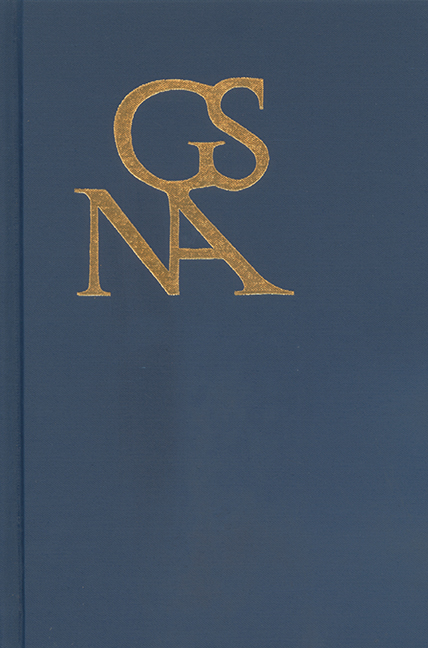Book contents
- Frontmatter
- Contents
- Special Section on Goethe and the Postclassical: Literature, Science, Art, and Philosophy, 1805–1815
- Helena, Then Hell: Faust as Review and Anticipation of Modern Times
- Histrionic Nationality: Implications of the Verse in Faust
- Die Wette in Goethes Faust
- Ecocriticism, the Elements, and the Ascent/Descent into Weather in Goethe's Faust
- Grablegung im Vorhof des Palasts: Groteske Anschaulichkeit in den vorletzten Szenen von Faust II
- Goethes Gnostiker: Fausts vergessener Nihilismus und sein Streben nach Erlösungswissen
- The Unconscious of Nature: Analyzing Disenchantment in Faust I
- Forms of Figuration in Goethe's Faust
- Goethe's Morphology of Knowledge, or the Overgrowth of Nomenclature
- Paraphrasis: Goethe, the Novella, and Forms of Translational Knowledge
- Dramas of Knowledge: The “Fortunate Event” of Recognition
- gegen: Bewegungen durch Goethes “Der Mann von funfzig Jahren”
- “Offenbares Geheimnis” oder “geheime Offenbarung”? Goethes Märchen und die Apokalypse
- Goethe's Green: The “Mixed” Boundary Colors in Zur Farbenlehre
- For Heaven's Sake, I Will Have You Walk into the Dark: Grillparzer's Containment of Beethoven and the Ambivalence of Their Melusina Project
- Imitation, Pleasure, and Aesthetic Education in the Poetics and Comedies of Johann Elias Schlegel
- Feindlich verbündet: Lessing und die Neuen Erweiterungen der Erkenntnis und des Vergnügens
- Juvenalian Satire and the Divided Self in Goethe's “Das Tagebuch”
- Book Reviews
Forms of Figuration in Goethe's Faust
from Special Section on Goethe and the Postclassical: Literature, Science, Art, and Philosophy, 1805–1815
Published online by Cambridge University Press: 14 March 2018
- Frontmatter
- Contents
- Special Section on Goethe and the Postclassical: Literature, Science, Art, and Philosophy, 1805–1815
- Helena, Then Hell: Faust as Review and Anticipation of Modern Times
- Histrionic Nationality: Implications of the Verse in Faust
- Die Wette in Goethes Faust
- Ecocriticism, the Elements, and the Ascent/Descent into Weather in Goethe's Faust
- Grablegung im Vorhof des Palasts: Groteske Anschaulichkeit in den vorletzten Szenen von Faust II
- Goethes Gnostiker: Fausts vergessener Nihilismus und sein Streben nach Erlösungswissen
- The Unconscious of Nature: Analyzing Disenchantment in Faust I
- Forms of Figuration in Goethe's Faust
- Goethe's Morphology of Knowledge, or the Overgrowth of Nomenclature
- Paraphrasis: Goethe, the Novella, and Forms of Translational Knowledge
- Dramas of Knowledge: The “Fortunate Event” of Recognition
- gegen: Bewegungen durch Goethes “Der Mann von funfzig Jahren”
- “Offenbares Geheimnis” oder “geheime Offenbarung”? Goethes Märchen und die Apokalypse
- Goethe's Green: The “Mixed” Boundary Colors in Zur Farbenlehre
- For Heaven's Sake, I Will Have You Walk into the Dark: Grillparzer's Containment of Beethoven and the Ambivalence of Their Melusina Project
- Imitation, Pleasure, and Aesthetic Education in the Poetics and Comedies of Johann Elias Schlegel
- Feindlich verbündet: Lessing und die Neuen Erweiterungen der Erkenntnis und des Vergnügens
- Juvenalian Satire and the Divided Self in Goethe's “Das Tagebuch”
- Book Reviews
Summary
In memory of my sister, Jane Rima Mehl So klar beweglich bleibt das Bild der Lieben Mit Flammenschrift ins treue Herz geschrieben.
JEAN-LUC NANCY's DISCUSSION of the Kantian schema in The Ground of the Image characterizes the European “transformation of thought” between the sixteenth and the nineteenth centuries as an epochal shift “from painting to the projection screen,” or “from sight (vue) to vision,” by which he means “from representation to presentation …, from the idea to the image, or, more precisely, from the fantasy or fantasm to the imagination.” Nancy's time-span, of course, precisely encompasses the historical arc of Faust. Consequently, his list of the transformative changes that were witnessed between Luther and Goethe could easily serve as an historical and theoretical frame for analyzing the problem of figuration in Faust, which similarly features the work of the imagination and thereby shifts the attention of its protagonist and spectator—in the spirit of Nancy's formulation—from “being to appearing” or from “ontology to phenomenology” (Nancy 80).
Even the casual reader of Faust will notice how the complex of figurative structures at work throughout Goethe's play move with compelling immediacy across the impassioned, personal investments of part one, only to re-emerge as the characteristically rarefied abstractions of part two, with its challenging allegorical and symbolic exhibitions. However, rather than valorize the poetic figure (Bild), in line with Emrich, within an ontological-genetic framework as a referential form that reveals origins in history, or expose it, along with Flax, as a site of deconstructive semiosis, I will take my cue from Nancy in the following remarks and reframe the discussion about figuration (Bildlichkeit) in Faust by exploring the transcendental quality of the play's figurative processes. To initiate this kind of post-Kantian re-evaluation of the Faust-stage, especially in part two, as a site where the poetic figure is analyzed in terms of the inherent (a priori) capacity of the Goethean imagination to animate and sustain thought—despite, or perhaps, because of Faust's cognitive and moral shortfalls—I will consider (more modestly here) just a few familiar passages, largely from the first part of the work—with the exception of Faust's journey to the Mothers.
- Type
- Chapter
- Information
- Goethe Yearbook 17 , pp. 133 - 152Publisher: Boydell & BrewerPrint publication year: 2010



